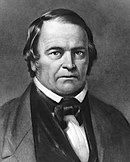Joshua V. Himes
Joshua V. Himes | |
|---|---|
 Joshua V. Himes | |
| Born | Joshua Vaughan Himes 1805 |
| Died | 1895 |
| Spouse | Mary Thompson Handy |
| Part of a series on |
| Adventism |
|---|
 |
|
|
Joshua Vaughan Himes (1805–1895) was a Christian leader and publisher. He became involved with the followers of William Miller and later became a prominent leader in the Advent Christian Church.
Biography
Himes was born in Wickford, Rhode Island. His parents intended for him to become an Episcopal priest, but when a business deal went sour he was unable to complete his education and was apprenticed to a cabinetmaker in New Bedford, Massachusetts. At 18 he joined the Christian Connexion church in New Bedford where he was licensed as an exhorter. In November 1825 he married Mary Thompson Handy, and the following year was ordained to the ministry. Over the next few years he pastored several districts in Massachusetts, before becoming pastor of the First Christian Church in Boston in 1830. There he rose to prominence, reviving a church that was near death, and becoming active in the educational, temperance, peace, and abolitionist reform movements of the day.
Himes met William Miller in 1839 at Exeter, New Hampshire. Impressed, he invited Miller to speak at the Chardon Street Chapel on Chardon Street in Boston.[1] From these lectures Himes became convinced of the imminent return of Christ, and sought opportunities for Miller to preach. In 1840 he published and edited the first Millerite newspaper, the Signs of the Times, in Boston.[2] He led in organizing general conferences and camp meetings, and published hundreds of pamphlets as well as the second and third editions of Miller's lectures. He organized extensive lecture tours for Miller and himself as far west as Cincinnati, brought about the manufacture of the "great tent," at that time the largest tent in the United States, for use on these tours, and established a network of agents, book depots, and reading rooms from Boston to St. Louis. He also published the Thayer lithograph of the first Millerite prophetic chart, designed by Charles Fitch and Apollos Hale. In 1842 he started a second newspaper, the Midnight Cry,[3] in New York City. Himes' promotional work brought Millerism to the attention of the world.
Like Miller, Himes at first opposed the setting of October 22, 1844 as the exact date for the return of Christ, but accepted it shortly before the date arrived. After the Great Disappointment when Jesus did not return on this day, he played a leading role in trying to reorganize the disappointed Adventists around the original Advent faith at the Albany Conference in April 1845. When this failed he became a leader of the Evangelical Adventists and their American Millennial Association (1858), opposing Sabbatarian Adventism and their understanding of the sanctuary as well as those who believed in conditional immortality and the re-establishment of Israel before Christ's Second Coming.
In 1863 Himes accepted the doctrine of conditional immortality, joined the Advent Christian Church, and moved his family west to Buchanan, Michigan, assuming a prominent leadership role among Advent Christians and starting a newspaper, The Voice of the West (later Advent Christian Times). In 1865 he was the founding president of the American Advent Mission Society, and was further planning to start a college in Illinois.
See also
- Advent Christian Church
- Adventist, Millerites
- Second Coming
- Seventh-day Adventist Church
- Christian revival
- Christianity in the 19th century
- List of religions and religious denominations#Adventist and related churches
- List of Christian denominations#Millerites and comparable groups
- Other movements in Category:Adventism
- Great Disappointment
- William Miller (preacher)
- Millennialism
- Second Great Awakening
References
- ^ Hewitt, Clyde E. (1983). Midnight and Morning. Advent Christian General Conference of America. p. 80.
- ^ Signs of the Times, adventistarchives.org
- ^ Midnight Cry, llu.edu
